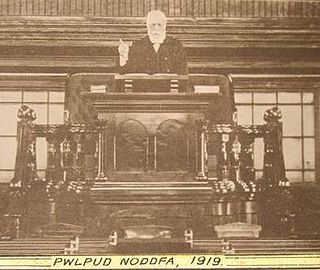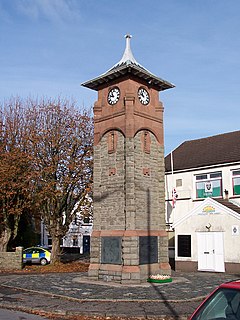The first election to the Cardiganshre County Council was held in January 1889. It was followed by the 1892 election. The county was divided into numerous single member wards with two councillors elected to represent Cardigan, Lampeter, New Quay and Llandysul, and four to represent the town of Aberystwyth. 37 Liberals, 10 Conservatives and 1 Unionist were returned.
The second election for the Cardiganshire County Council took place in March 1892. It was preceded by the inaugural 1889 election and followed by the 1895 election

William Morris (1843–1922), widely known by his bardic name, Rhosynnog was the minister of Noddfa Baptist Church, Treorchy, South Wales from soon after its formation in 1868 until his death.
The second election to the Glamorgan County Council was held on 8 March 1892. The 1889 election was the first contest and the next was the 1895 election. Glamorgan County Council had been established by the 1888 Local Government Act, and the first election held in January 1889. Glamorgan was by far the largest county in Wales in terms of population. The county of Glamorgan was at this time becoming heavily industrialised, although some areas such as the Vale of Glamorgan remained essentially rural. The rise of nonconformist liberalism, especially since the 1860s, throughout Wales, had challenged the prevailing influence of the landed gentry. However, even in 1889, the traditional forces remained influential and no working men were elected to the Council. This changed in 1892 with the unopposed return of David Morgan in Aberdare and the success of Isaac Evans in Resolven.
The third election to Glamorgan County Council election was held on 4 March 1895. It was preceded by the 1892 election and followed by the 1898 election.
The Glamorgan County Council election, 1898 was the fourth contest for seats on this authority. It was preceded by the 1895 election and followed by the 1901 election. Glamorgan was by far the largest county in Wales in terms of population. Glamorgan County Council had been established by the 1888 Local Government Act, and the first elections held in early 1889. The county of Glamorgan was at this time becoming heavily industrialised, although some areas such as the Vale of Glamorgan remained essentially rural. The rise of nonconformist liberalism, especially since the 1860s, throughout Wales, had challenged the prevailing influence of the landed gentry. However, even in 1889, the traditional forces remained influential and no working men were elected to the Council. This changed in 1892 with the unopposed return of David Morgan in Aberdare and the success of Isaac Evans in Resolven.
The Glamorgan County Council election, 1901 was the fifth contest for seats on this authority. It was preceded by the 1898 election and followed by the 1904 election. Glamorgan was by far the largest county in Wales in terms of population. Glamorgan County Council had been established by the 1888 Local Government Act, and the first elections held in early 1889. The county of Glamorgan was at this time becoming heavily industrialised, although some areas such as the Vale of Glamorgan remained essentially rural. The rise of nonconformist liberalism, especially since the 1860s, throughout Wales, had challenged the prevailing influence of the landed gentry. However, even in 1889, the traditional forces remained influential and no working men were elected to the Council. This changed in 1892 with the unopposed return of David Morgan in Aberdare and the success of Isaac Evans in Resolven.
The Glamorgan County Council election, 1904 was the sixth contest for seats on this authority. It was preceded by the 1901 election and followed by the 1907 election. Glamorgan was by far the largest county in Wales in terms of population. Glamorgan County Council had been established by the 1888 Local Government Act, and the first elections held in early 1889. The county of Glamorgan was at this time becoming heavily industrialised, although some areas such as the Vale of Glamorgan remained essentially rural. The rise of nonconformist liberalism, especially since the 1860s, throughout Wales, had challenged the prevailing influence of the landed gentry. However, even in 1889, the traditional forces remained influential and no working men were elected to the Council.
The community of Aberaman, Rhondda Cynon Taf was an electoral ward for much of the twentieth century, for the purposes of electing members to Glamorgan County Council and the Aberdare Urban District Council. It currently comprises two electoral wards, Aberaman North and Aberaman South, for the purposes of electing members to the Rhondda Cynon Taf County Borough Council. Aberaman North is composed mainly of Aberaman itself while Aberaman South includes Abercwmboi, Cwmaman, Godreaman and Glynhafod.
The fifth elections for Cardiganshire County Council took place in March 1901. They were preceded by the 1898 election and followed by the 1904 election
The sixth elections for Cardiganshire County Council took place in March 1904. They were preceded by the 1901 election and followed by the 1907 election
The Glamorgan County Council election, 1907 was the seventh contest for seats on this local authority in Wales. It was preceded by the 1904 election and followed by the 1910 election.
Aberdare Town was, for much of the twentieth century, an electoral ward for the purposes of electing members to Glamorgan County Council and the Aberdare Urban District Council. It currently comprises two electoral wards, Aberdare East and Aberdare West, for the purposes of electing members to the Rhondda Cynon Taf County Borough Council. Aberdare East is composed mainly of a part of Aberdare itself while Aberdare West includes the community of Llwydcoed which, for many years was itself as electoral ward.
The Glamorgan County Council election, 1910 was the eighth contest for seats on this authority. It was preceded by the 1907 election and followed by the 1913 election.
The ninth elections for Cardiganshire County Council took place in March 1913. They were preceded by the 1910 election and followed by the 1919 election as no election took place in 1916 due to the First World War.
The second election to the Merionethshire County Council was held in March 1892. They were preceded by the 1889 election and followed by the 1895 election.
The Glamorgan County Council election, 1913 was the ninth contest for seats on this authority. It was preceded by the 1910 election and followed, due to the First World War, by the 1919 election.
An election to Glamorgan County Council took place in March 1919. It was preceded by the 1913 election and followed by the 1922 election.






